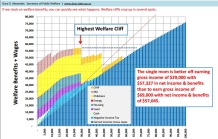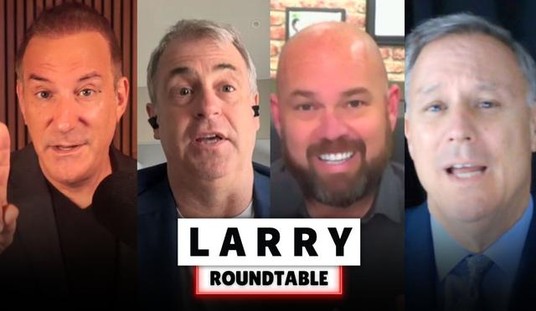I’ve shared many charts over the years, but two of the most compelling ones deal with poverty.
 The numbers in this chart, which are based on Census Bureau data and scholarly studies (see here, here, here, and here), show that the poverty rate was steadily falling in the United States – until the federal government decided to launch a so-called War on Poverty.
The numbers in this chart, which are based on Census Bureau data and scholarly studies (see here, here, here, and here), show that the poverty rate was steadily falling in the United States – until the federal government decided to launch a so-called War on Poverty.
Once Washington got more involved and started spending trillions of dollars, we stopped making progress. The poverty rate has changed a bit with shifts in economic conditions, but it’s stayed remarkably steady between 11 percent and 15 percent of the population.
 So why have we stopped making progress? This second chart shows how redistribution programs create a dependency trap. The plethora of handouts from government make self-reliance and work comparatively unattractive, particularly since poor people are hit with very high implicit marginal tax rates.
So why have we stopped making progress? This second chart shows how redistribution programs create a dependency trap. The plethora of handouts from government make self-reliance and work comparatively unattractive, particularly since poor people are hit with very high implicit marginal tax rates.
And just as rich people respond logically to incentives, the same is true of poor people.
In a recent debate with a representative of the Center for American Progress, I tried to make these points. I doubt I had any effect on her outlook, but hopefully viewers began to see that the welfare state has been bad news for taxpayers and bad news for poor people.
Our debate was cut short by the host, but I think it was a fair representation of each side’s views.
And if you want more information on this topic, my former colleague from my days at the Heritage Foundation, Robert Rector, assesses the War on Povertyfor today’s Wall Street Journal.
He starts with some very sobering numbers.
Fifty years later, we’re losing that war. Fifteen percent of Americans still live in poverty, according to the official census poverty report for 2012, unchanged since the mid-1960s. Liberals argue that we aren’t spending enough money on poverty-fighting programs, but that’s not the problem. …The federal government currently runs more than 80 means-tested welfare programs that provide cash, food, housing, medical care and targeted social services to poor and low-income Americans. Government spent $916 billion on these programs in 2012 alone, and roughly 100 million Americans received aid from at least one of them, at an average cost of $9,000 per recipient. …Federal and state welfare spending, adjusted for inflation, is 16 times greater than it was in 1964. If converted to cash, current means-tested spending is five times the amount needed to eliminate all official poverty in the U.S.
Recommended
He then explains that poor people don’t suffer from material deprivation (which may explain why the Obama Administration wants to manipulate the numbersto justify more welfare spending).
…the typical American living below the poverty level in 2013 lives in a house or apartment that is in good repair, equipped with air conditioning and cable TV. His home is larger than the home of the average nonpoor French, German or English man. He has a car, multiple color TVs and a DVD player. More than half the poor have computers and a third have wide, flat-screen TVs. The overwhelming majority of poor Americans are not undernourished and did not suffer from hunger for even one day of the previous year.
Robert then gets to the heart of the issue, explaining that the welfare state has expanded dependency and exacerbated social pathologies.
…consider LBJ’s original aim. He sought to give poor Americans “opportunity not doles,” planning to shrink welfare dependence not expand it. …By that standard, the war on poverty has been a catastrophe. The root “causes” of poverty have not shrunk but expanded as family structure disintegrated and labor-force participation among men dropped. A large segment of the population is now less capable of self-sufficiency than when the war on poverty began. …In 1963, 6% of American children were born out of wedlock. Today the number stands at 41%. As benefits swelled, welfare increasingly served as a substitute for a bread-winning husband in the home. …children raised in the growing number of single-parent homes are four times more likely to be living in poverty than children reared by married parents of the same education level. …Even in good economic times, a parent in the average poor family works just 800 hours a year, roughly 16 hours weekly, according to census data. Low levels of work mean lower earnings and higher levels of dependence.
Mr. Rector also has some specific suggestions in his column, most of which seem sensible, but this is where I think my idea of sweeping decentralization and federalism is very appropriate.
P.S. Thomas Sowell’s indictment of the welfare state is must reading.
P.P.S. Some honest leftists now acknowledge that big government creates worrisome forms of dependency.
P.P.P.S. If you want to know how dependency varies by state, here’s a map showing welfare payments and another map showing food stamp usage.
 P.P.P.P.S. Shifting to a bigger stage, my least favorite international bureaucracy has made the preposterous claim that poverty is a bigger problem in America than it is in basket-case nations such as Greece and Portugal. Not that we should be surprised since the OECD actively urges a bigger welfare state in the United States.
P.P.P.P.S. Shifting to a bigger stage, my least favorite international bureaucracy has made the preposterous claim that poverty is a bigger problem in America than it is in basket-case nations such as Greece and Portugal. Not that we should be surprised since the OECD actively urges a bigger welfare state in the United States.
P.P.P.P.P.S. And don’t forget our Moocher Hall of Fame if you want examples of the human cost of the welfare state.

























Join the conversation as a VIP Member